How to Grill Beef Brisket on Charcoal

Jump to Recipe
This smoked brisket recipe turns out incredibly flavorful, tender brisket. Whether you have a dedicated smoker or want to smoke it on a basic charcoal grill, I have step by step instructions for both (with process shots and video)!
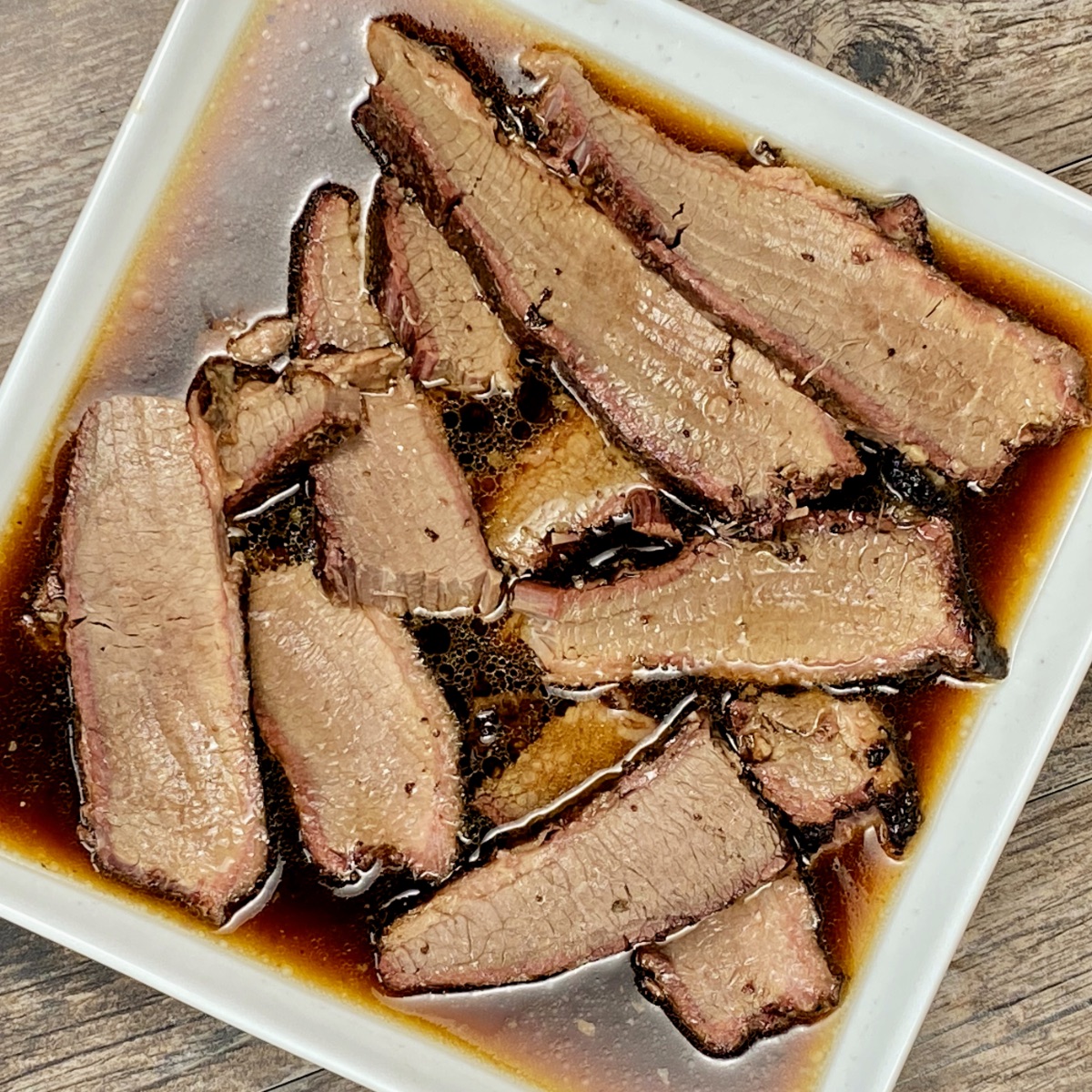
What's better than smoked brisket? The rich beef flavor of fork-tender meat, that is enhanced by the smoke process. Yum, yum!
This was my "go-to" dish at my local BBQ joint. The only problem was that I never got enough...and it's expensive! After hearing this one too many times, Michelle said, "I bet you could make this at home, and better". Challenge accepted!
Well, I am happy to report that she was right. This recipe is simple to follow and turns out incredible smoked beef brisket. Let me show you the way...
First, let's talk smokers. Regardless of the type of smoker you have, this recipe will work for you. If you don't have smoker, you can make this on a basic charcoal grill. Just make sure to follow my instructions on How to Smoke on a Charcoal Grill.
Here's a little secret: I own three dedicated smokers, but prefer to smoke brisket on my Weber kettle. It just tastes better.
If you are smoking on a charcoal grill, watch out for these red boxes in the post: they have additional instructions to follow.
Second, let's talk brisket. This recipe will walk you through how to smoke a brisket flat or whole packer brisket (the entire brisket: point and flat). When you're choosing your brisket, make sure to purchase choice grade or better. Personally, I prefer to buy Costco brisket. It's prime grade, and always at a great price.
So stick around…I'll cover every step and show you how to make the best smoked brisket you'll ever eat.
Below is a linked outline of topics: feel free to jump around or follow along in order.
Jump to:
- What is brisket?
- What do I need to smoke brisket?
- How long does it take to smoke brisket?
- How much brisket per person?
- How to prep a brisket
- Brisket rub recipe (no-salt)
- How to apply rub to the brisket
- What temp to smoke brisket?
- Pre-heat the smoker
- How to smoke a brisket
- When is brisket done?
- How long to rest brisket
- Why save the brisket juice?
- Prepare brisket for slicing
- How to slice brisket
- How to serve smoked brisket
- What to serve with brisket
- How to reheat brisket
- Can you freeze smoked brisket?
- Leftover brisket ideas
- Want more smoked meat recipes?
- Smoked Brisket (Charcoal Grill or Smoker)
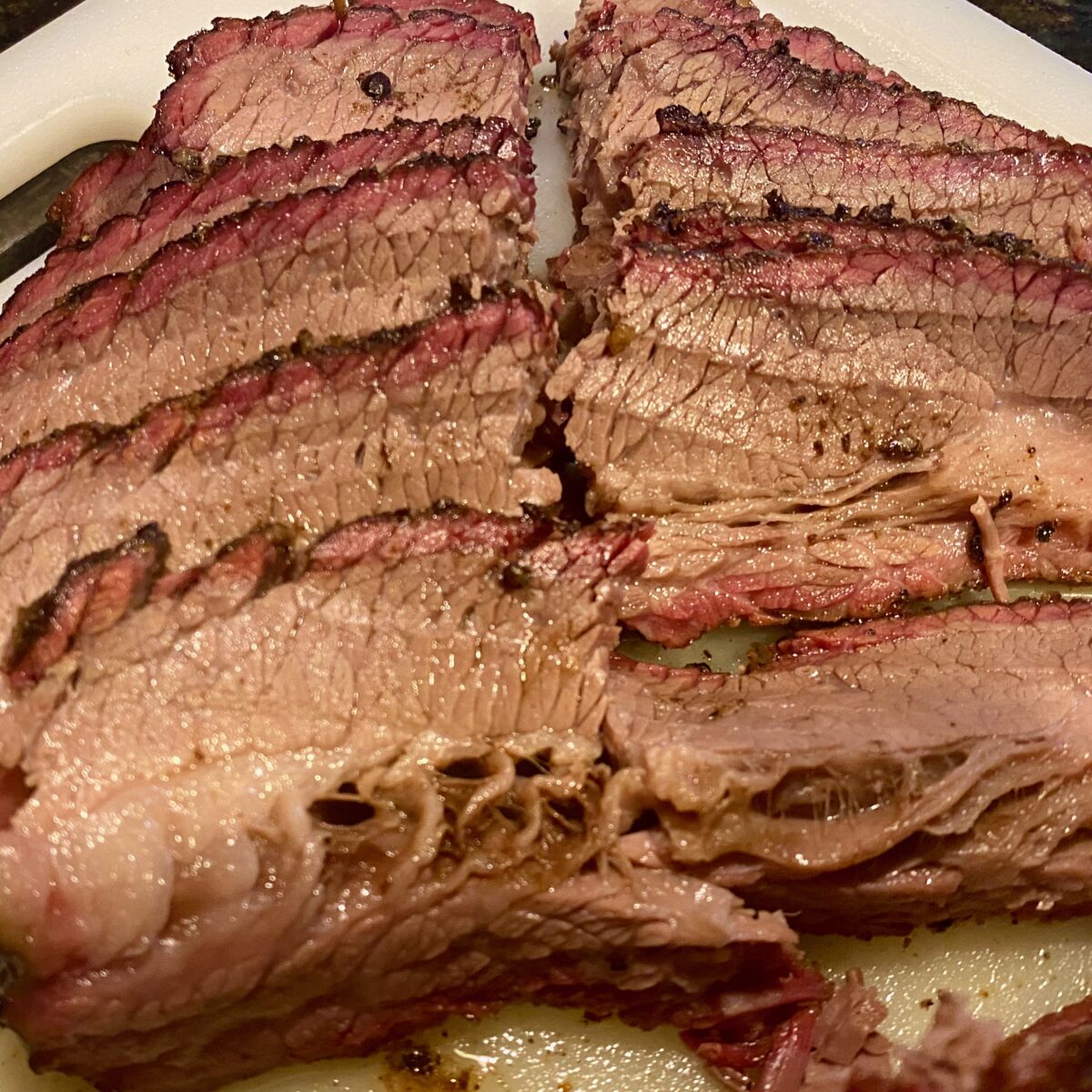
What is brisket?
Beef brisket is a large cut of meat (12–14 pounds) that actually consists of two muscles that overlap, one is called the "flat" and the other is the "point". You can either smoke the entire brisket (as mentioned above, this is known as a "packer brisket"), or smoke the flat or point cuts separately. The flat is thinner and very lean, while the point is thicker and is marbled with fat.
Now an anatomy lesson, because yes, we're geeks. Brisket is made up of muscles from the pectoral region of the steer, which is heavily exercised. This makes for a tough piece of meat because the muscles are full of connective tissue that has to break down. But fear not! This makes brisket an ideal candidate for the low and slow smoking process.
What do I need to smoke brisket?
- A smoker (or charcoal grill, set up to smoke)
- Beef brisket (flat, point, or whole packer brisket)
- Worcestershire sauce & beef broth
- Beef rub (recipe below)
- Tinfoil
How long does it take to smoke brisket?
This can vary widely depending on a variety of factors:
- Are you smoking a packer brisket or just the flat?
- What is the cooking temperature?
- Are you wrapping in tinfoil or not?
- At what internal temp do you wrap?
For my recipe, the approximate cook time on the grill is about 8 hours for a flat and 10 hours for a packer brisket. But you also need to account for an additional rest time of 2 hours.
Resting a brisket is critical to juicy, tender meat. Make sure to plan for a minimum 2 hour rest time!
I've even rested up to 4 hours: this allows me extra cook time in case the cook runs long. Don't worry about this extended rest time: I explain below how to safely rest smoked brisket for 4 hours.
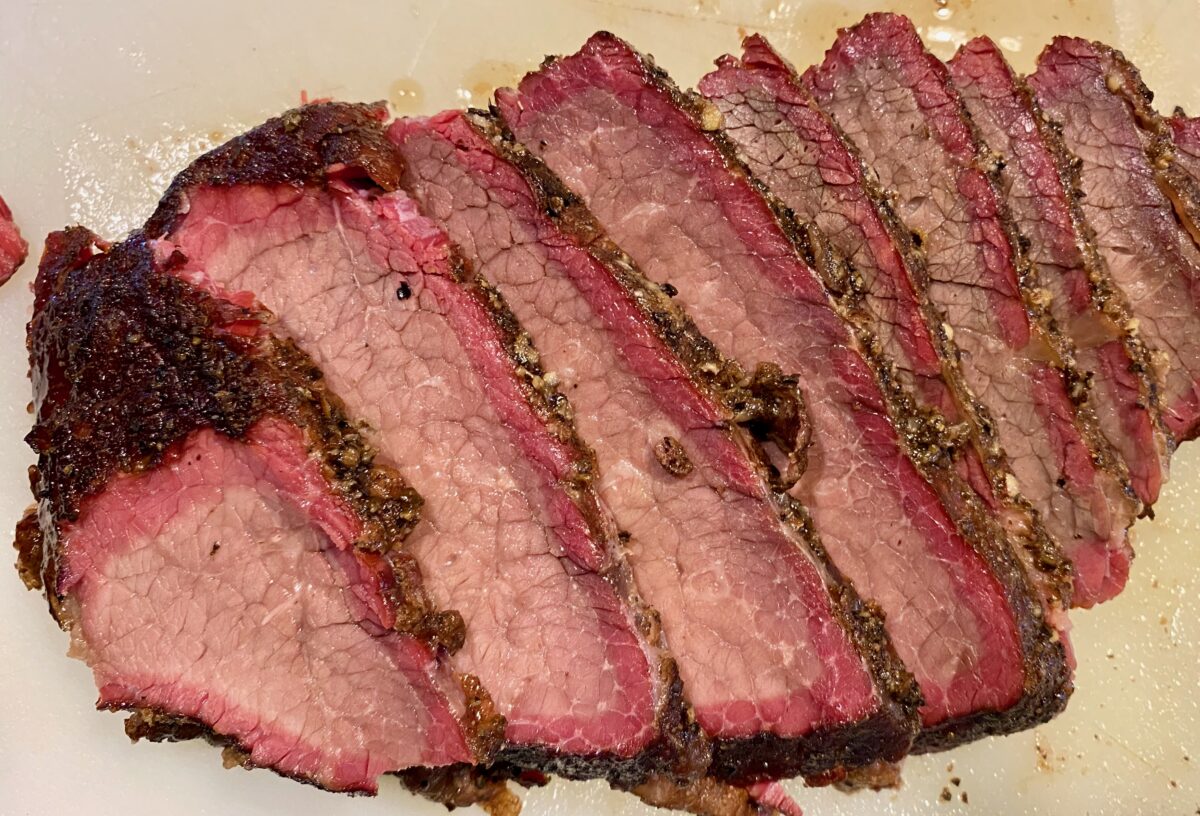
How much brisket per person?
If you're hosting a party, you'll of course want a good idea of how much beef brisket to smoke. Before we can answer that, there are some questions you need to answer:
- Is brisket going to be the only main course?
- Are you serving as sandwiches or meat by itself, or both?
- How many side dishes are there?
- Will there be dessert?
- Are your guests big beef eaters?
The rule of thumb is to assume about ½ pound of uncooked trimmed brisket per person. Then adjust this up or down after answering these questions.
I absolutely recommend making extra. The leftovers are so. Danged. GOOD. Make sure to check out my leftover brisket ideas at the end of this post.
How to prep a brisket
Before we can smoke a brisket, we have three prep steps that need to be done.
- Trim
- Rinse and dry
- Dry brine (optional, but worth it!)
How to trim a brisket
Whether you're smoking a flat or whole packer brisket, there will be a good amount of fat on one side, which is known as the fat cap. This is not a bad thing, and we definitely don't want to remove all of it.
Trim the fat cap down until you are left with about an ⅛ to ¼ inch of fat. This thin layer of fat will protect the meat during this long cook.
Be prepared to remove a lot of fat, especially if you're smoking a packer brisket. For example, on my 14.5 pound packer, I removed over 2 pounds of fat.
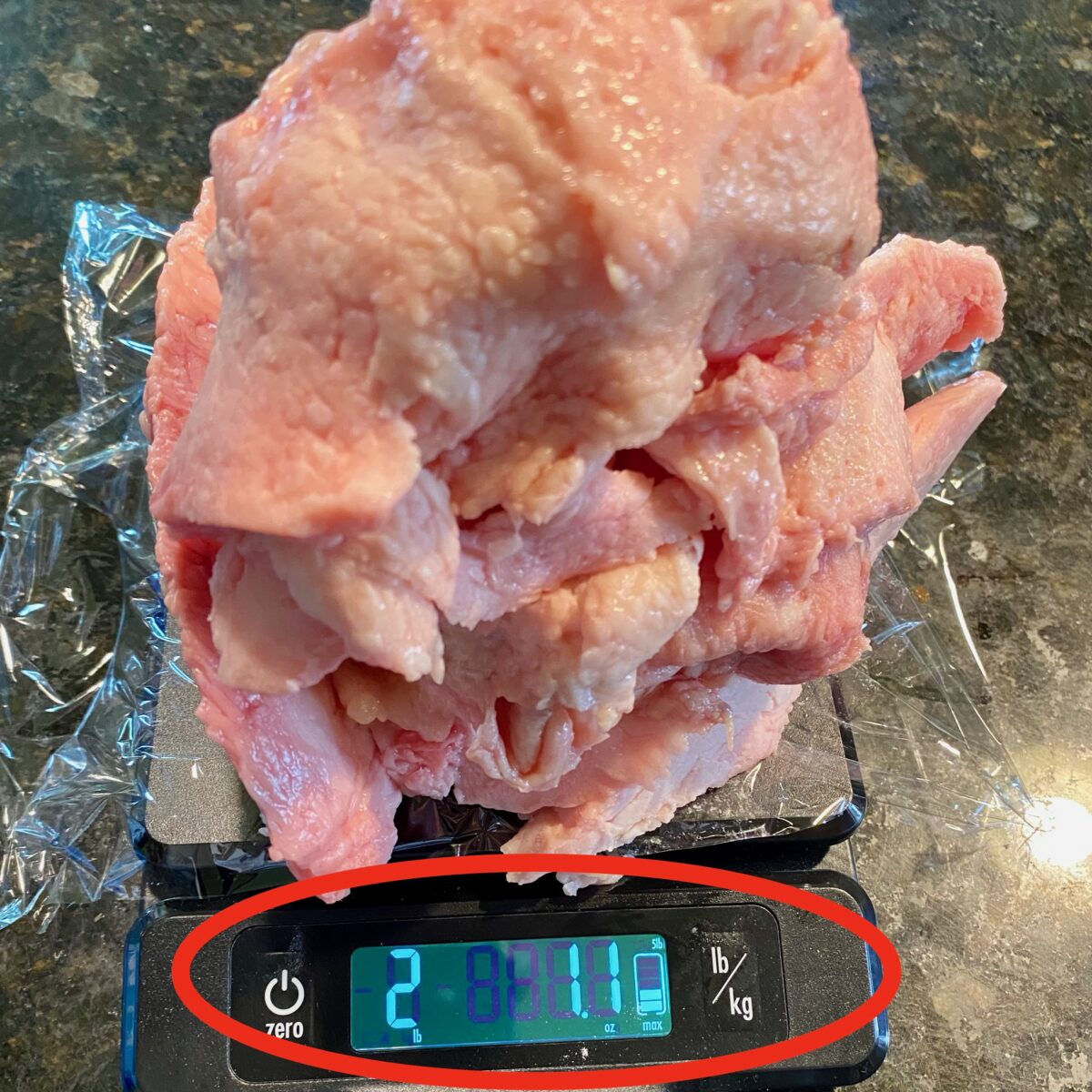
The other side, opposite the fat cap, should already be mostly trimmed by the butcher. Just remove any remaining fat and blueish silver skin that may remain.
If you're smoking a packer brisket, there will be a large pocket of fat where the point and flat meet. Just carve out a good chunk of it. You don't need to be perfect.
Last, you may notice some browned sections on the brisket after you remove it from the packaging. This is nothing to be alarmed about, but you should trim away these areas.
Back to that fat: don't throw it away! I recommend making tallow with it.
How to make tallow
Tallow is rendered down solid beef fat that you can use in place of oil or butter. It's perfect for searing any type of beef, like steaks, hamburgers, and reheating brisket. It adds incredible beefy flavor.
Making tallow is super simple. Simply add the fat trimmings to a sauce pan and turn the burner to low heat. Let this cook for about 60–90 minutes, which will allow much of the solid to render down into liquid fat. Discard whatever fat pieces are left and strain the liquid into an airtight container. Store in the fridge (or freezer) until needed.
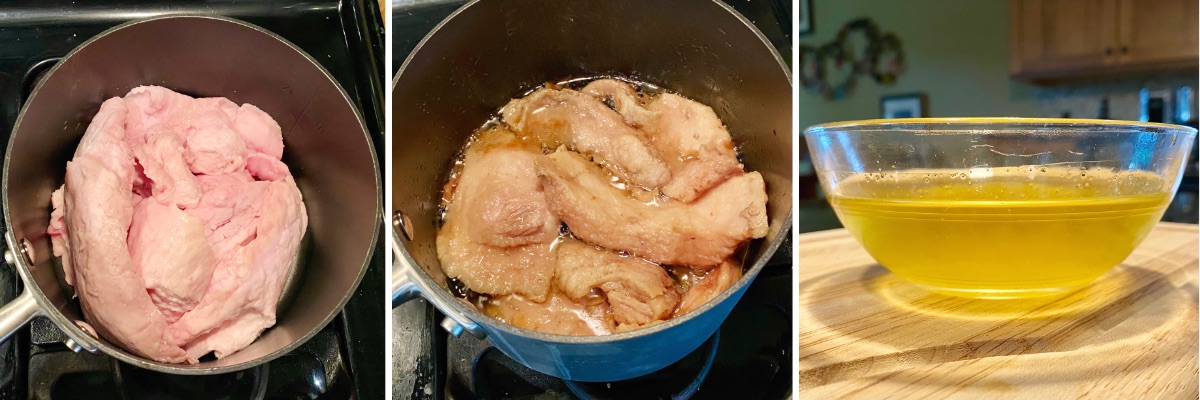
Rinse, then dry the brisket
After trimming, it's a good idea to wash off any residual brine and/or blood on the brisket. Dry well with a paper towel.
Dry brine the brisket
Don't be scared-off by the term "dry brine". Dry brining is just pre-salting the meat. How simple is that?
While this is optional, I strongly recommend it. It will produce tastier and juicier brisket. (Check out this great article by Serious Eats if you want to learn more about dry brining.)
To dry brine, sprinkle ½ teaspoon of kosher salt per pound of trimmed brisket. (Use ¼ teaspoon per pound if you're using table salt.)
Once salted, place the brisket on a cooling rack set inside of a large rimmed baking sheet. Rest this in your fridge, uncovered, anywhere from 12–48 hours before smoking it. This allows the dry brine process to do its work.
Only dry brine if you are going to use a brisket rub that does not have salt in it. I provide a great, simple no-salt recipe below.
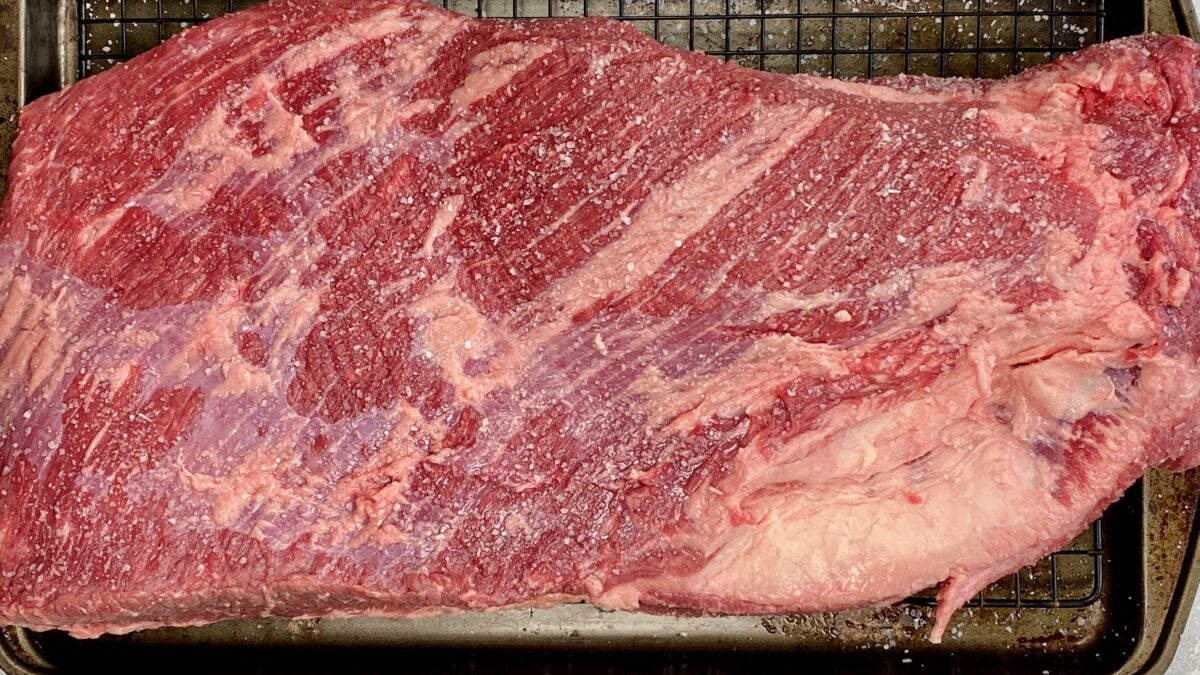
Benefits of dry brining
Dry brining allows the salt to penetrate deeper into the meat rather than just on the surface. This provides more flavor throughout the meat.
An added benefit is that when the salt penetrates into the muscle cells, it essentially traps water molecules and holds them during the cook process. This prevents the meat from drying out during long cook times, leaving you with juicier meat!
Brisket rub recipe (no-salt)
Beef brisket has fabulous flavor it its own right, I want the rub to enhance it, not change it. My rub only has 2 ingredients. (3 if you count salt, which you will need to add if you choose not to dry brine)
- 2 tablespoons Ground black pepper
- 2 teaspoons Granulated garlic powder
(If you didn't dry brine, add 2 tablespoons Kosher salt to this rub)
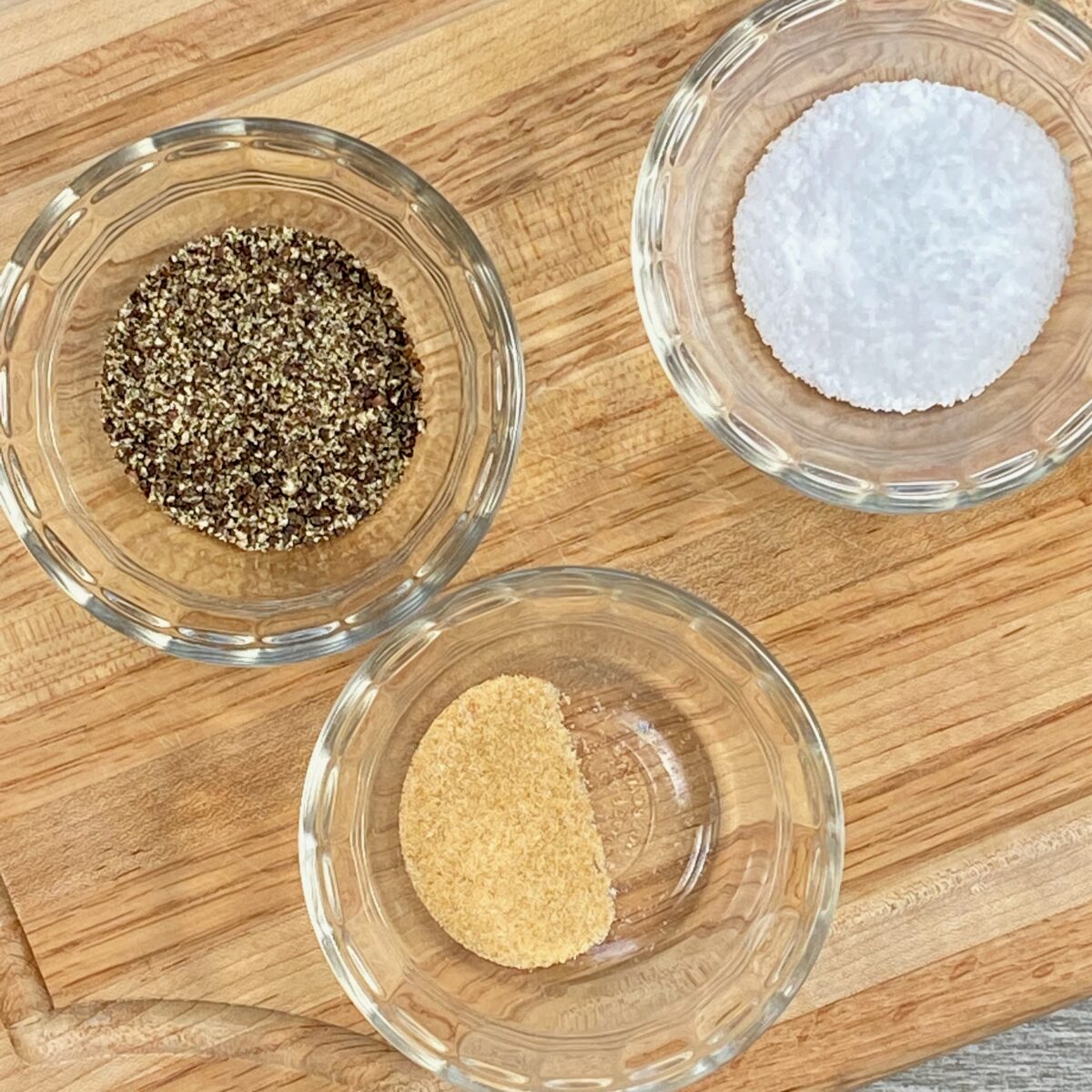
How to apply rub to the brisket
There are so few ingredients to this rub that I prefer to sprinkle each ingredient on separately to ensure adequate coverage.
Before applying the rub, apply a few dashes of Worcestershire sauce to the brisket—just enough to wet it down a bit. This will act as a binder to hold the rub.
Apply the brisket rub about 1–2 hours before putting the meat on the smoker. If you're doing an early morning cook, applying the night before is fine too.
If you are using a commercial brisket rub, it likely has lots of salt in it. If that is the case, DO NOT dry brine the brisket. Just go directly to rubbing your brisket with your commercial rub.
How much rub to put on the brisket
I go by looks. More precisely, I am going by the coverage of the black pepper. Everybody will have a different preference for black pepper, so adjust this up or down to your liking. Below is the coverage I like.
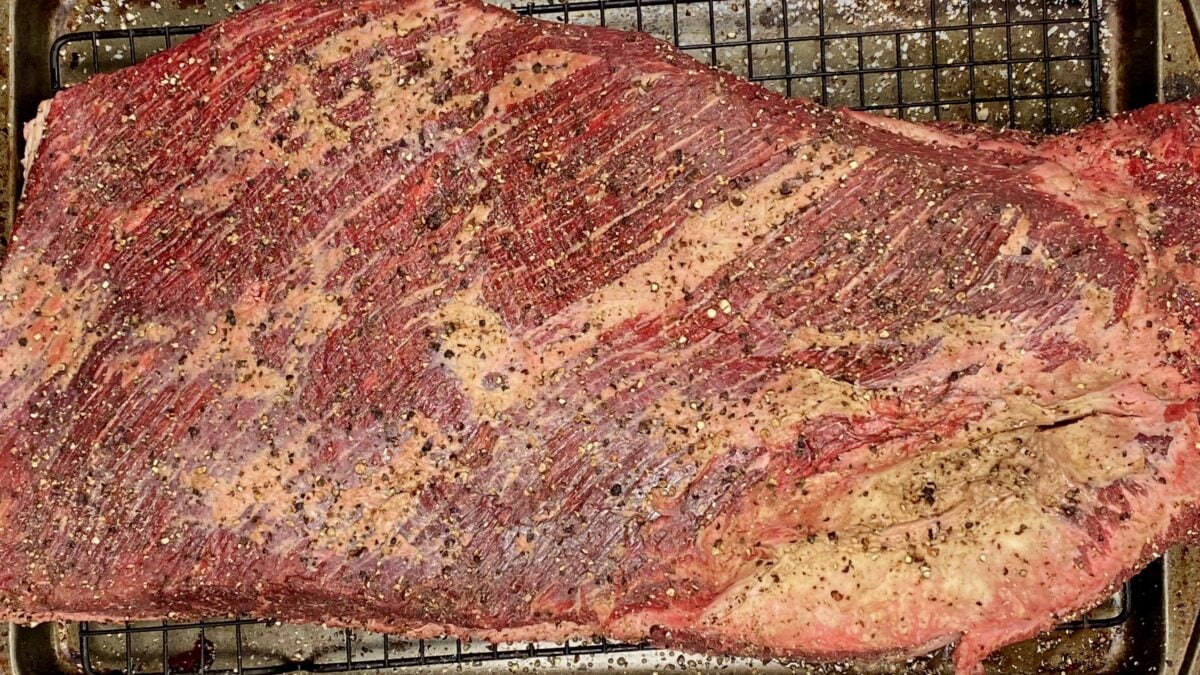
After it's rubbed down, put the brisket back into the fridge until it's time to smoke. We want the brisket cold when it goes on the smoker because this allows for more smoke absorption.
What temp to smoke brisket?
I have found that 250 ºF is the best temp for smoked brisket. It does a better job of rendering the fat than the more common temp of 225 ºF.
Pre-heat the smoker
Time to get smokin'! Pre-heat your smoker to 250 ºF.
If you don't have a smoker, you can cook a whole packer brisket or flat on a basic charcoal grill. Make sure to follow my instructions on How to Smoke on a Charcoal Grill.
How to smoke a brisket
There are many ways to smoke a brisket, but usually it comes down to two types of people: those who wrap and those who don't. The term "wrap" means that at some point in the cook process, the brisket gets wrapped in tinfoil.
I have smoked brisket both ways, many times, and have determined that the best smoked brisket comes from wrapping. They simply come out juicier and more tender.
When you're smoking brisket using the wrap method, there are two phases in the cook process.
Phase 1 - Smoke the brisket unwrapped
At this point the smoker should be pre-heated to 250 ºF and clean smoke should be coming from your grill. Clean smoke is important because it is in this first phase that all the smoke absorption happens.
Place the brisket on the smoker.
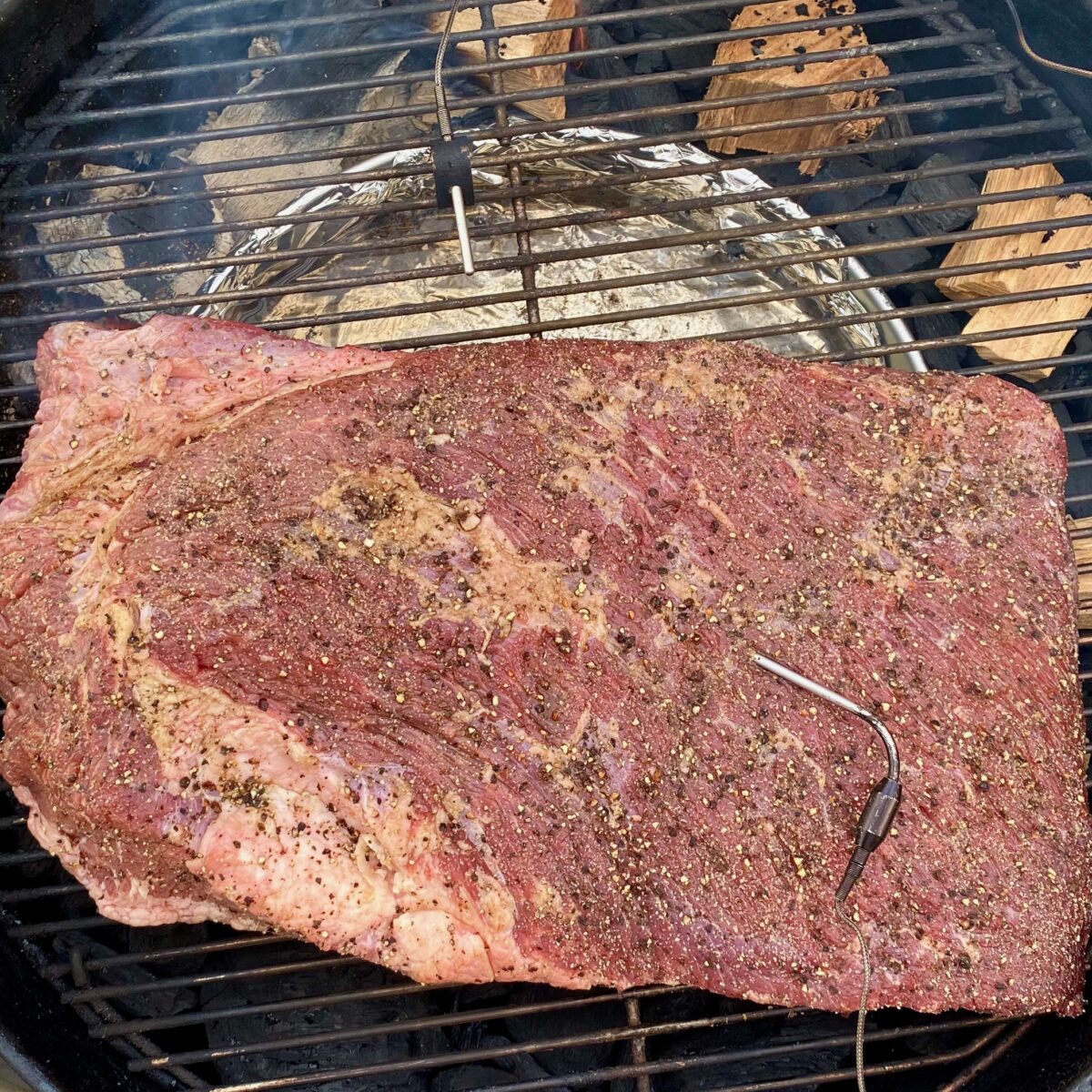
Smoke brisket fat side up or down?
When you're smoking brisket, you want the fat side facing the direction that your heat is coming from. This fat cap insulates the meat from the heat. All smokers are different, so investigate to see where your heat source is located.
If you're smoking on a charcoal grill, you should place it fat side down.
Cook the brisket until it reaches an internal temperature of 160 ºF. This will take about 5–7 hours depending on whether you are cooking a packer brisket or a flat.
If you're smoking a brisket flat on a charcoal grill, rotate your meat and grate every hour in this first phase.
If you're smoking a whole packer brisket, keep the thickest part always towards the coals by only rotating the grate every hour. The thicker part can handle this higher heat.
Where to put temp probe in brisket
Whether you are cooking a packer brisket or the flat, you want to take the internal temperature of the brisket in the thickest part of the flat. Although the point will be much larger, the flat is where you should take the temperature.
Phase 2 - Wrap the brisket in foil (a.k.a. "The Texas Crutch")
You want to wrap the brisket in foil when it reaches an internal temperature of 165 ºF. At this temperature, it will have absorbed plenty of smoke and a nice mahogany bark will have formed on the brisket.
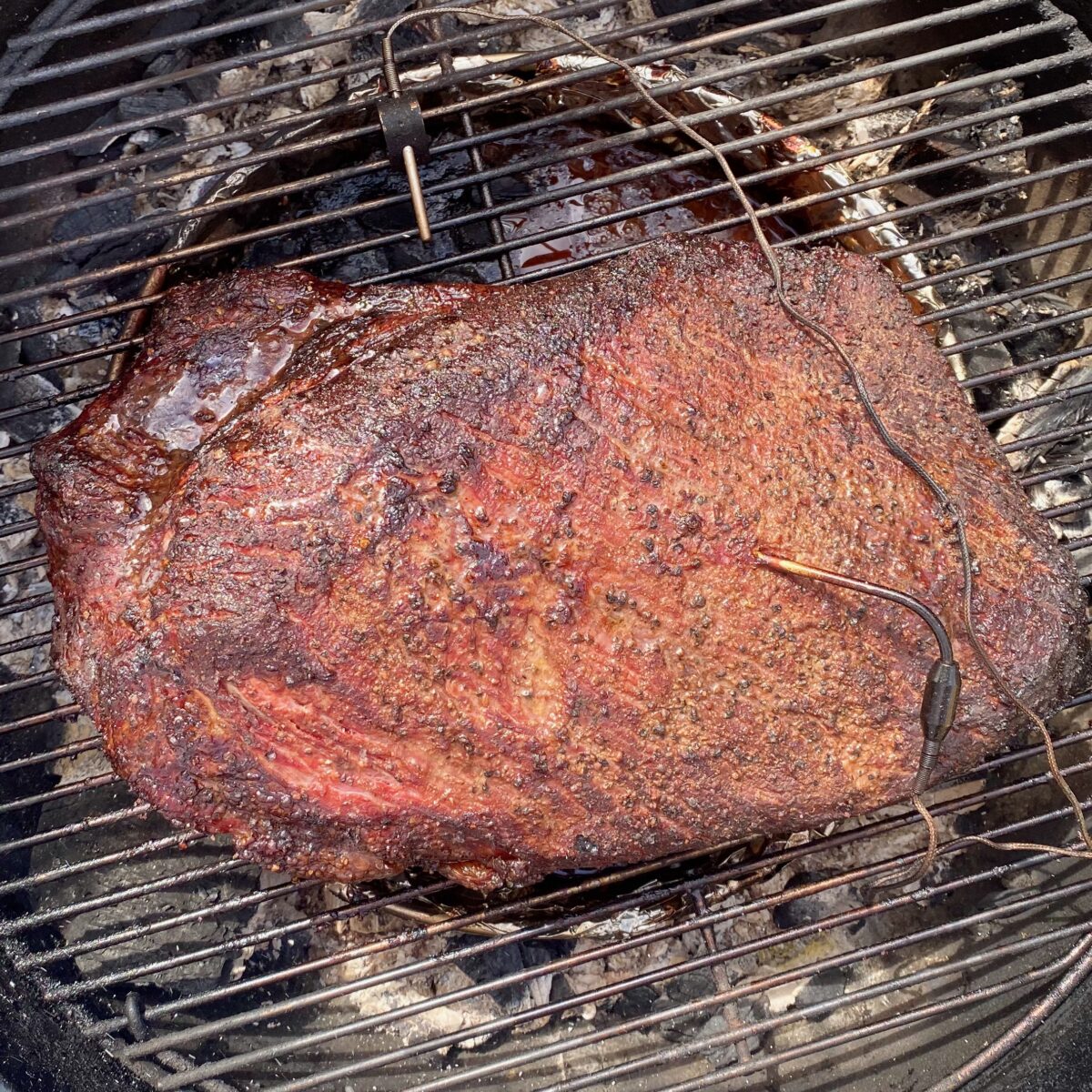
Why wrap brisket?
Wrapping in tinfoil, also known as "the Texas crutch," is done to help keep meat moist during very long cooks, and also to speed up cooking time by pushing through the dreaded BBQ stall.
The wrapping stage also stops the absorption of smoke. But don't worry: 5–7 hours of smoke is plenty. Nothing ruins BBQ more than too much smoke.
How to wrap a brisket in foil
Place a layer of tinfoil on a large, rimmed baking sheet. The tinfoil needs to be large enough so that there will be at least 4 inches of exposed tinfoil around the entire brisket once it is placed on top.
In the center of the tinfoil, press down to create a shallow well or bow in the middle. Pour ¼ cup of beef broth and a few dashes of Worcestershire sauce into this well.
Now place your partially cooked brisket, meat side down (fat side up), onto the tinfoil and beef broth.
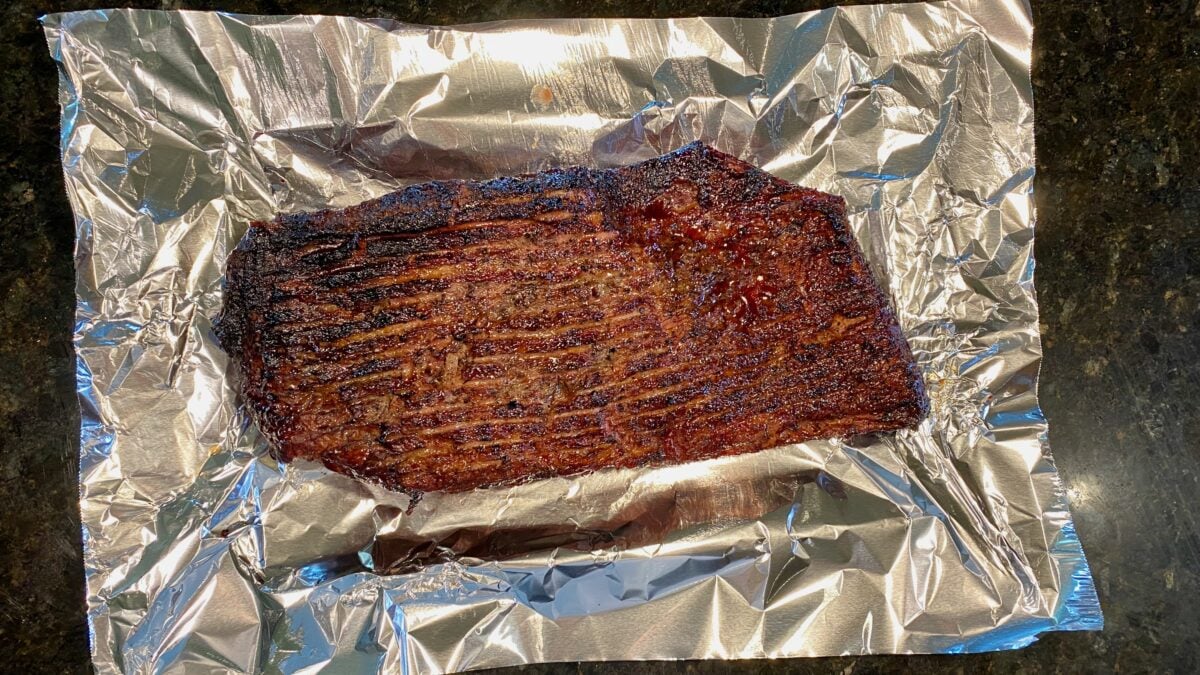
Now, take a second sheet of tinfoil (the same size as the first) and lay it over top of the first sheet with your brisket and broth. Then make multiple folds on all four sides of the sheets to create a tight seal. Continue folding on all four sides until you are up tight against the brisket.
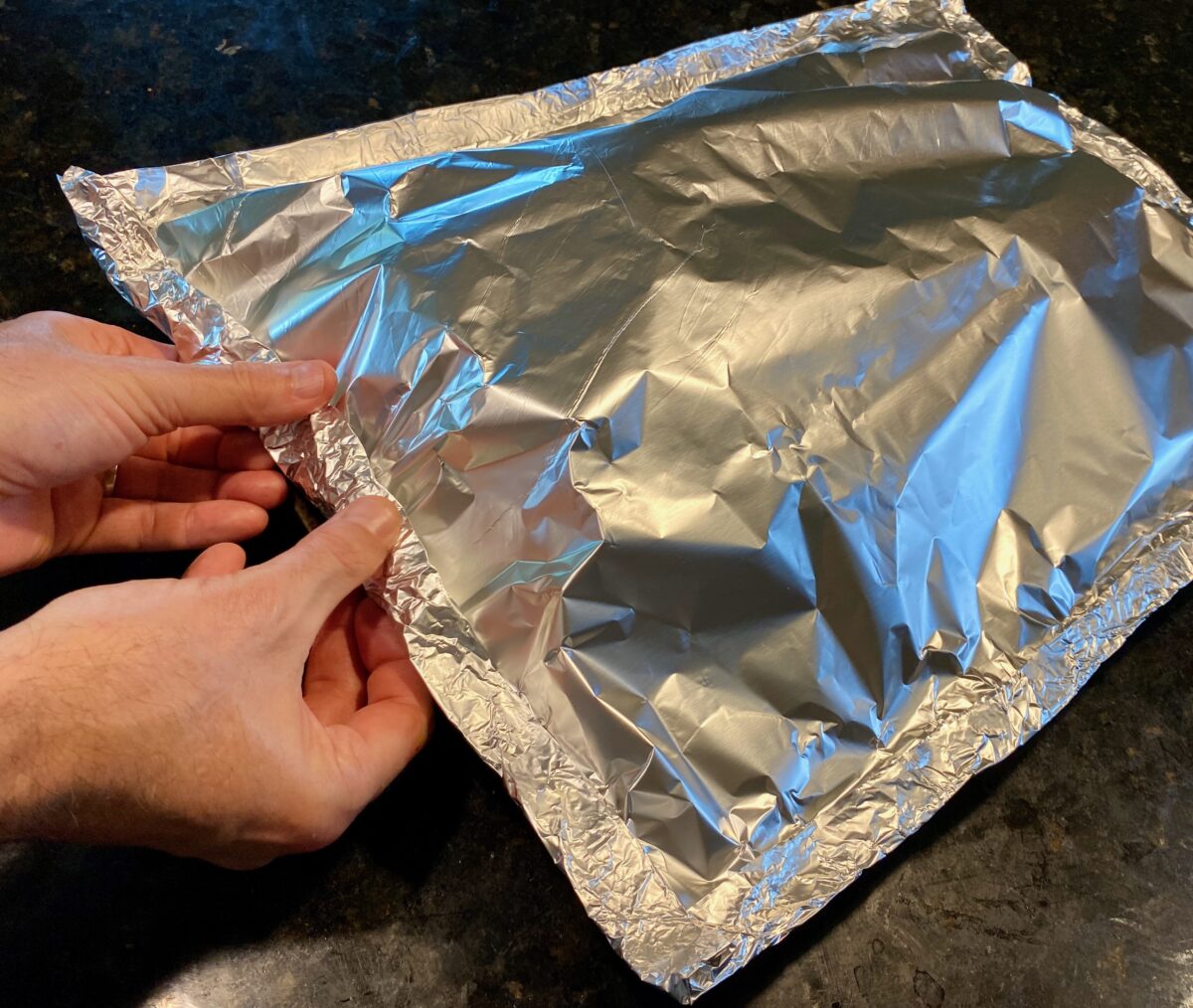
Once this is done, place the wrapped brisket on top of one more large sheet of foil. Make sure the meat side is still down (fat side up). Just fold all four sides of this third sheet up and over the top of the wrapped brisket.
This last layer is important. It's not uncommon for tinfoil to stick to the grate when you're removing it. This added layer ensures we won't lose all the flavorful juice that will be created inside the wrap.
Re-insert the meat thermometer through the top of the tinfoil and into the thickest part of the flat. Place it back on the grill, meat side down (fat side up). The meat side will braise in the broth and juice that is created.
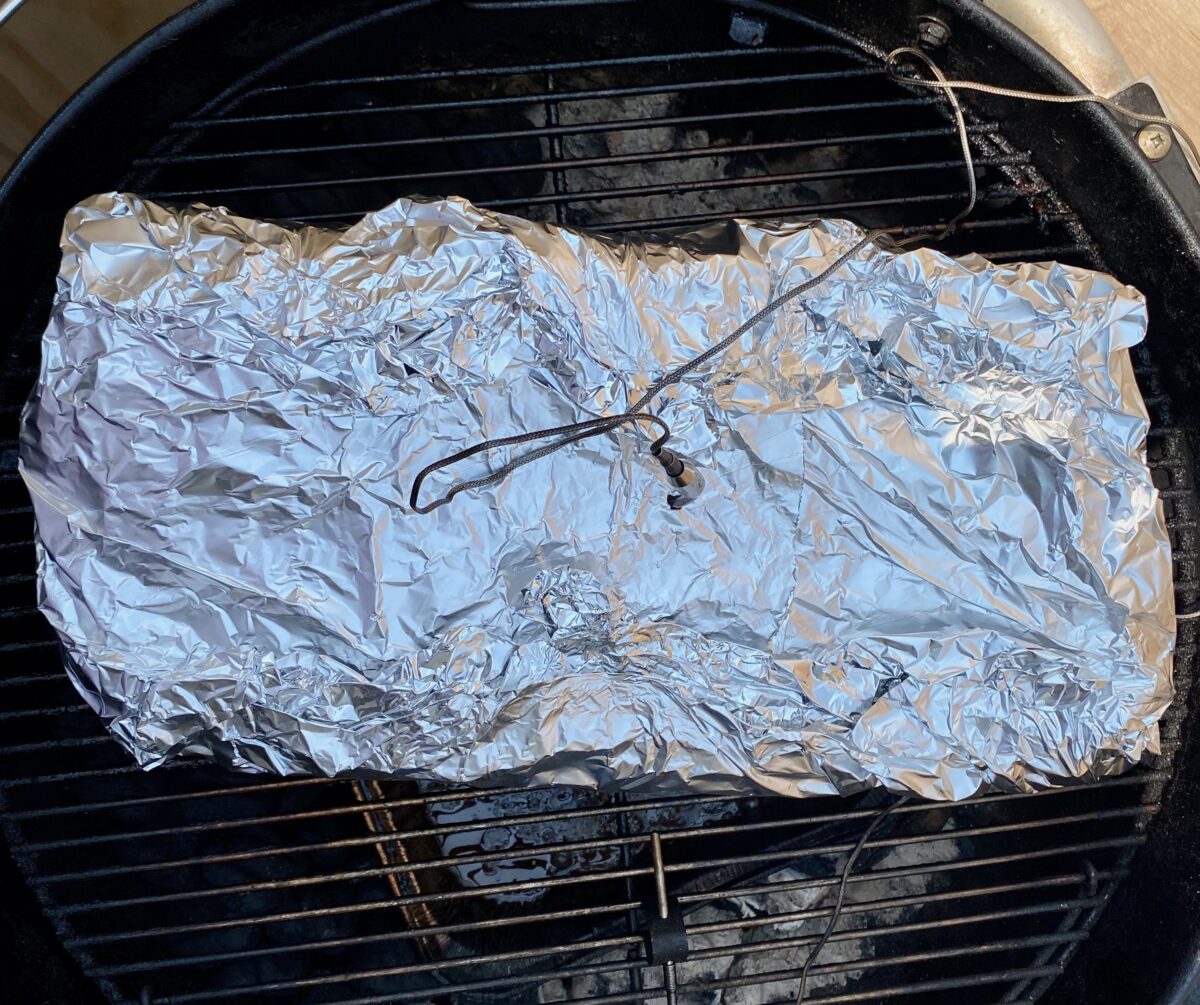
Why not wrap in butcher paper?
Yes, butcher paper is all the rage these days when it comes to wrapping brisket. I personally don't think it's warranted. There are two reasons I don't wrap my briskets in butcher paper:
- I don't notice any difference whether I wrap in butcher paper or tinfoil. I even reached out to my BBQ friends for their opinion, and they had the same conclusion.
- More importantly, if you use butcher paper, you lose all the flavorful juice created during this wrap phase. Using tinfoil enables us to capture all of it.
How long to cook brisket after wrapping
The additional cook time once a brisket has been wrapped is 3–4 hours.
If you're smoking a brisket flat on a charcoal grill, rotate your meat and grate every hour in this wrapped phase.
If you're smoking a whole packer brisket, keep the thickest part always towards the coals by rotating the grate every hour. The thicker part can handle this higher heat.
When is brisket done?
During the wrapped phase, the brisket will be done when it hits an internal temperature of 203 ºF. Once it reaches this temp, the fat and collagen have broken down, leaving you with extremely tender, juicy brisket.
Even though the brisket is done, it definitely is not ready to serve. It's critical to let the meat rest.
How long to rest brisket
Place the wrapped brisket on a baking sheet and allow it to rest at room temperature for a minimum of one hour (two hours would be better). This rest time allows the meat to relax and the juices to redistribute.
The rest period is critical to achieving tender, juicy smoked brisket.
How long can you rest a brisket?
If you need to rest the brisket longer than 2 hours, you can make a faux cambro (food warmer) by using the foil-towel-cooler method detailed below:
- Wrap the brisket in tinfoil (already done!)
- Wrap a towel around the brisket
- Place the wrapped brisket in a cooler to rest
This method will allow you to safely rest the brisket up to 4 hours. Once rested, it's time to get that flavorful brisket juice from inside the wrap.
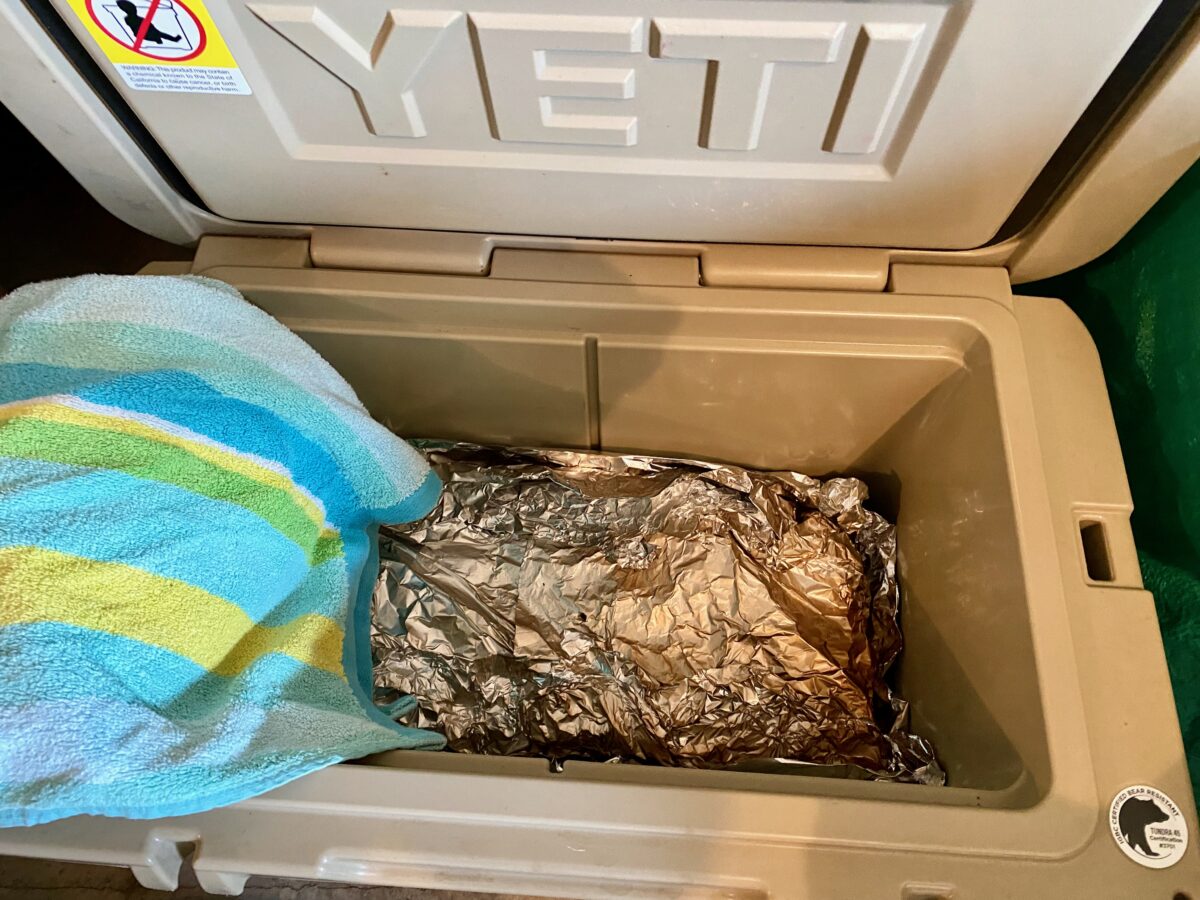
Why save the brisket juice?
Smoked brisket dries out soon after slicing. This juice has tremendous flavor: we'll use it for serving the sliced brisket. It essentially acts as an au jus.
Best way to get the juice out
To get the juice from the wrap, hold the wrapped brisket at a slight downward angle above a large mixing bowl. Then, with a knife, poke a hole into the bottom end of the tinfoil so that all the juice runs out into the bowl.
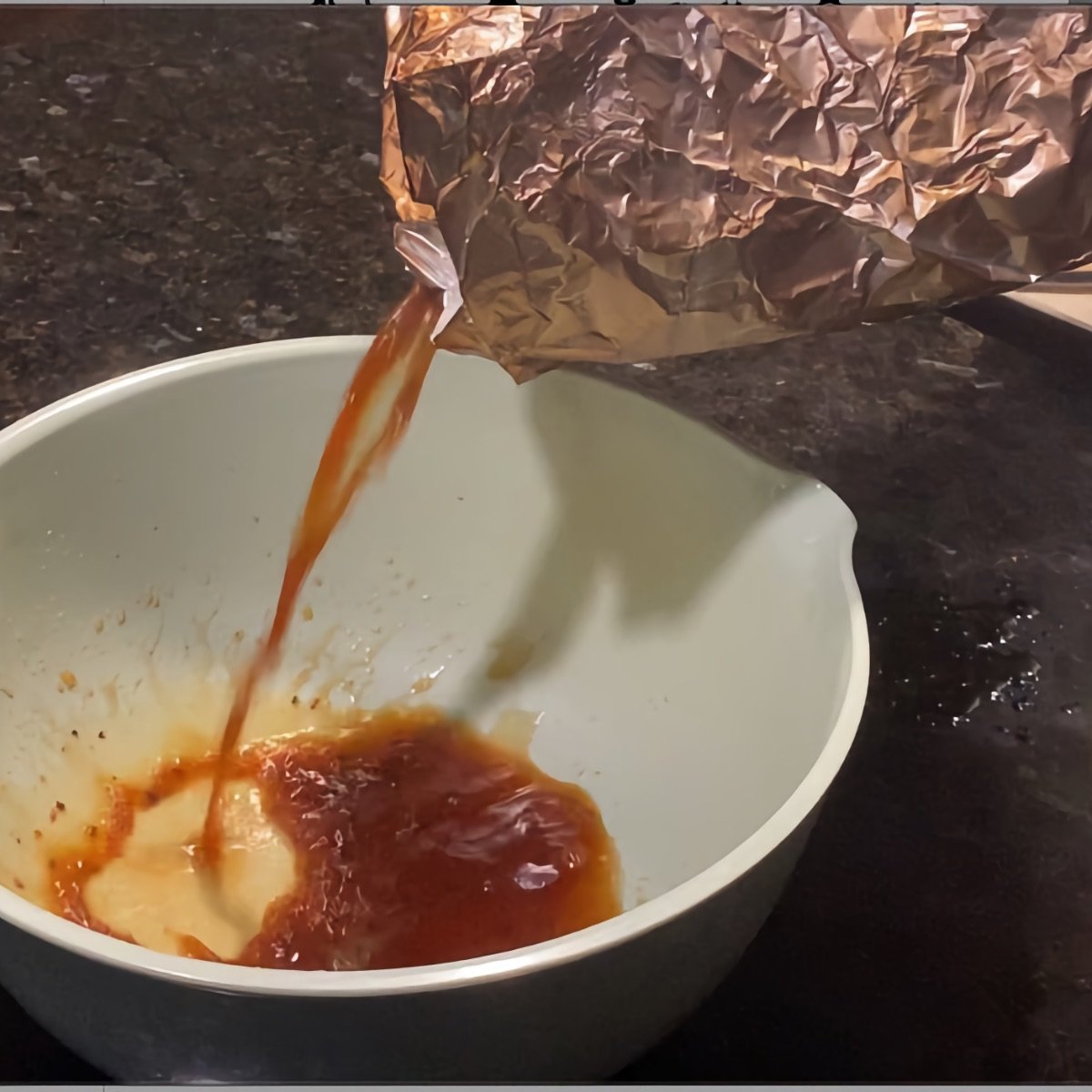
Then transfer it to a fat separator to remove the fat, which will leave you with rich, smoky beef brisket broth.
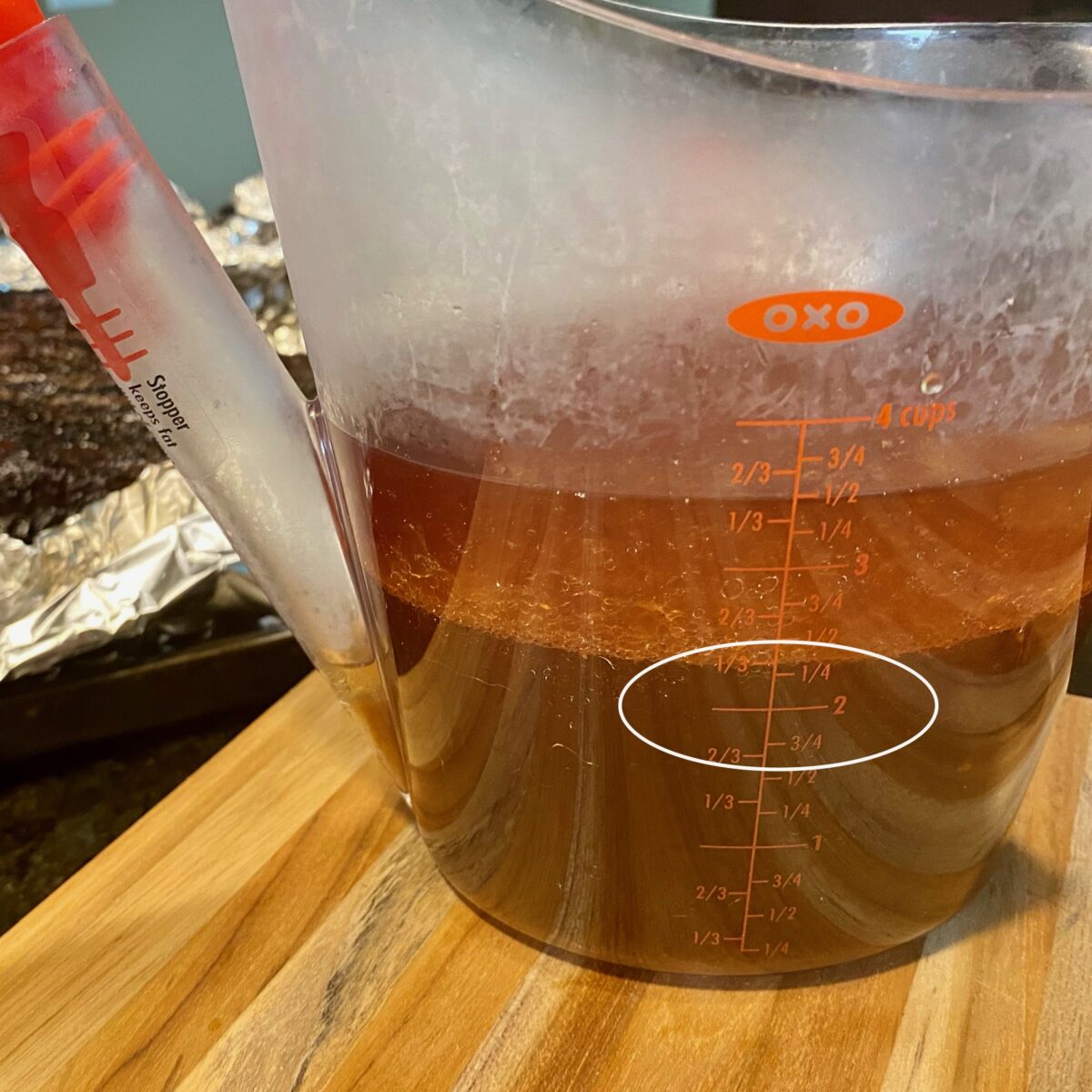
Now, fully unwrap the brisket and place it onto a cutting board so you can get the brisket ready to slice.
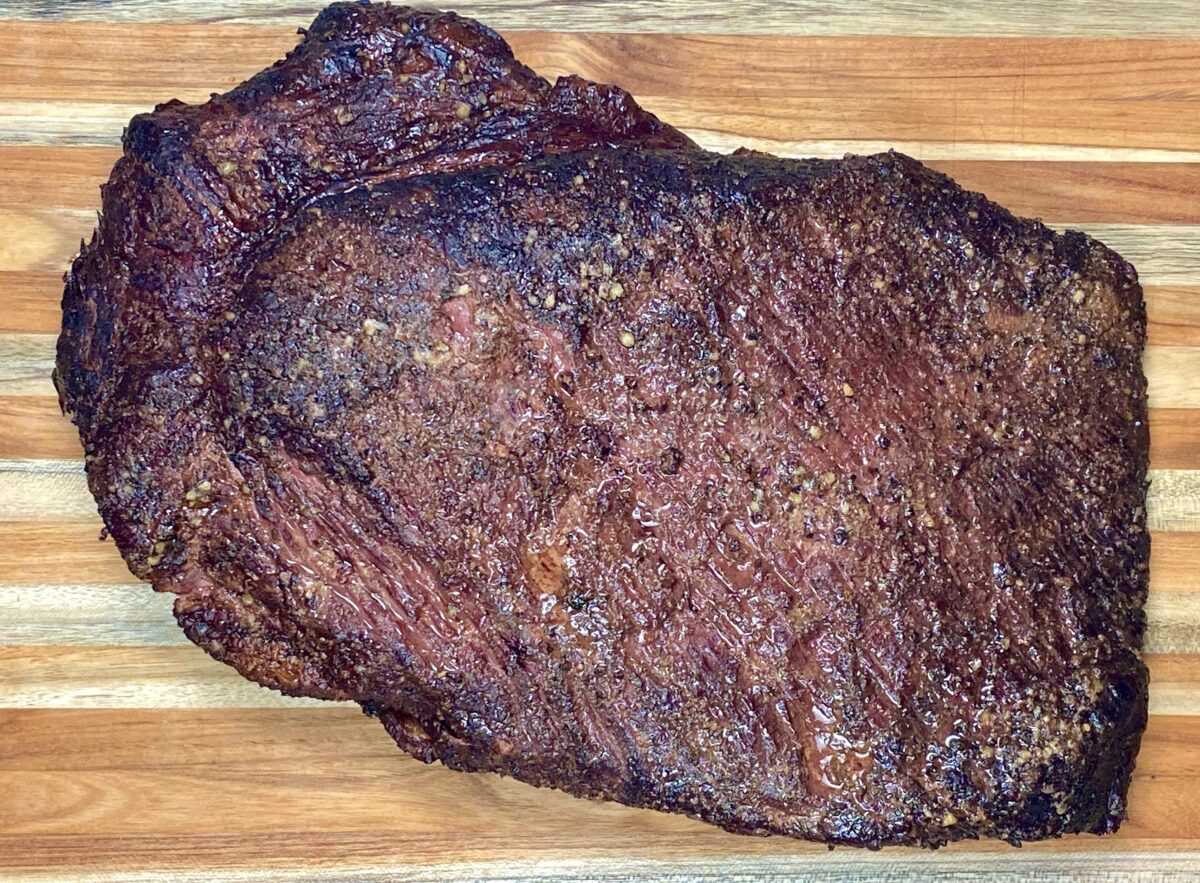
Prepare brisket for slicing
You want to slice brisket against the grain. If you only smoked a brisket flat, it should be very easy to see the direction the grain runs.
If you smoked a whole packer brisket, the grain in the point runs a different direction than the flat. Since the point sits directly over the flat, it's best to remove the point from the flat.
This shouldn't be too hard since you've now rendered and broken down the fat that connected these two muscles.
Once you've separated the muscles, scrape away all the rendered fat from where they were connected.
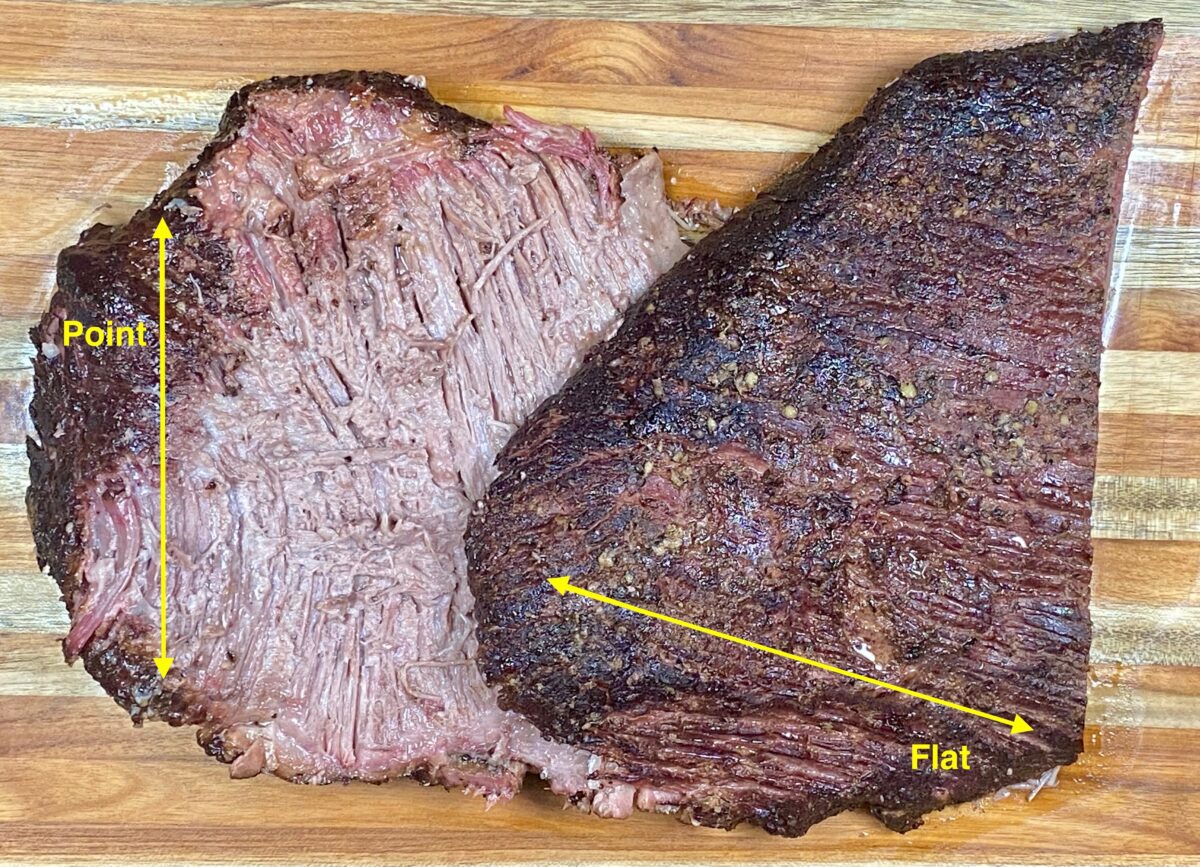
The picture above is a perfect illustration showing the different grain directions between the point and the flat cuts. After separating the two pieces and removing the fat that was between them, I shifted the flat to the right a few inches to expose the point's grain.
Now we are ready to slice some brisket.
How to slice brisket
Again, you want to slice brisket against the grain or muscle striation.
Once you have determined which way the muscle is running, cut slices about a ¼" thick.
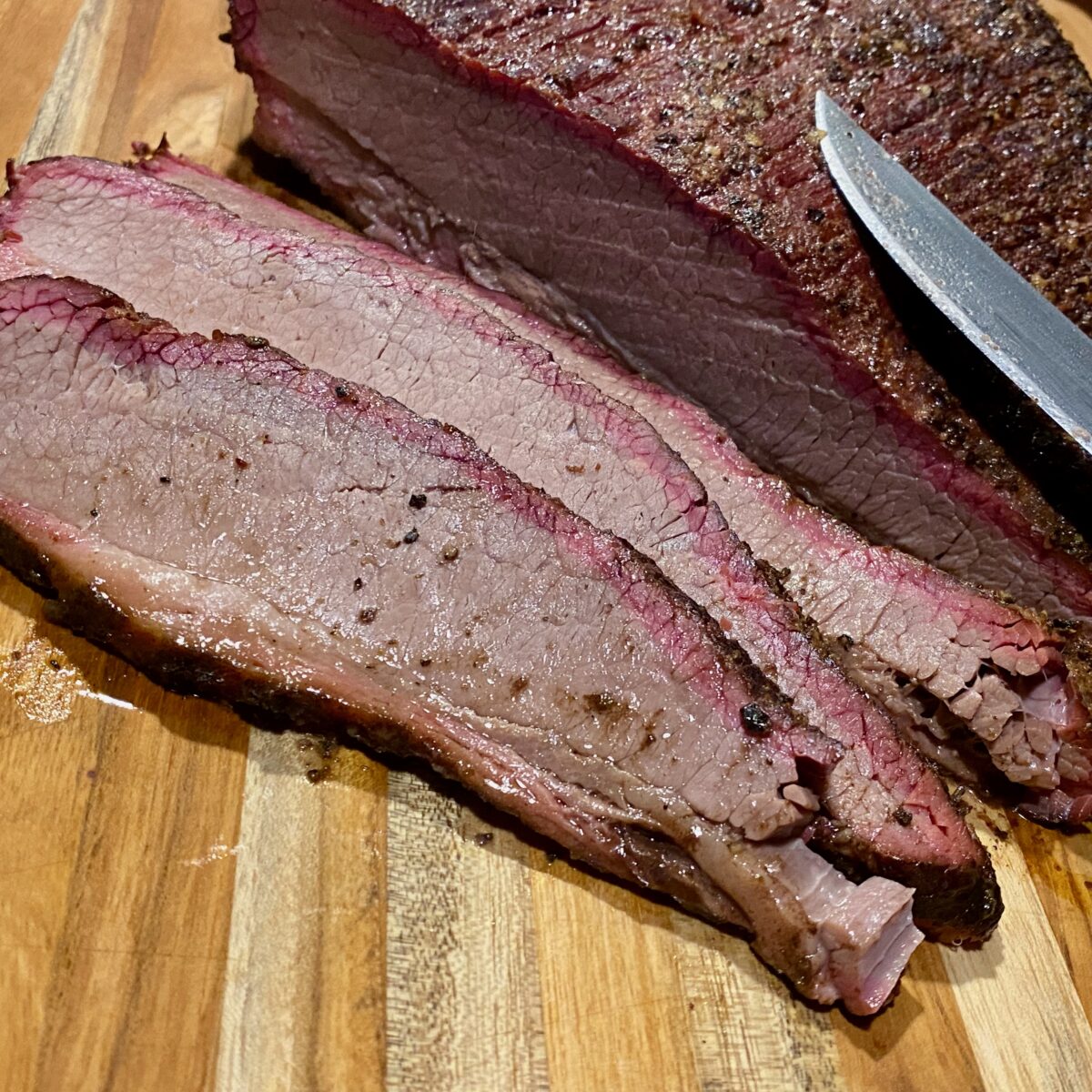
Slicing trick : While we all aspire to cook perfect brisket, that's not always how it turns out. If you find your brisket overdone and falling apart, cut thicker slices. If it is a bit underdone (a bit tough), cut thinner slices.
How to serve smoked brisket
Once you have sliced your beef brisket, simply add it to a crockpot or saucepan to keep warm. You will notice that the brisket flat can quickly dry out soon after slicing. This is why we saved the juice!
Add your brisket juice to the crockpot and let the brisket slices bathe in that flavorful smoked beef broth until serving time. (If you don't have enough brisket juice, mix in some beef broth.)
Then your guests can self serve the slices on buns or plates as they wish.
Serving hack: I prefer to make my brisket a day or two ahead. Once it's smoked, rested and all the fat has been trimmed, I wrap it in plastic and set it in the fridge.
Then on the day of the event, I slice it and place it in the crockpot to warm up with the brisket juice. It turns out just as good as the day it was cooked!
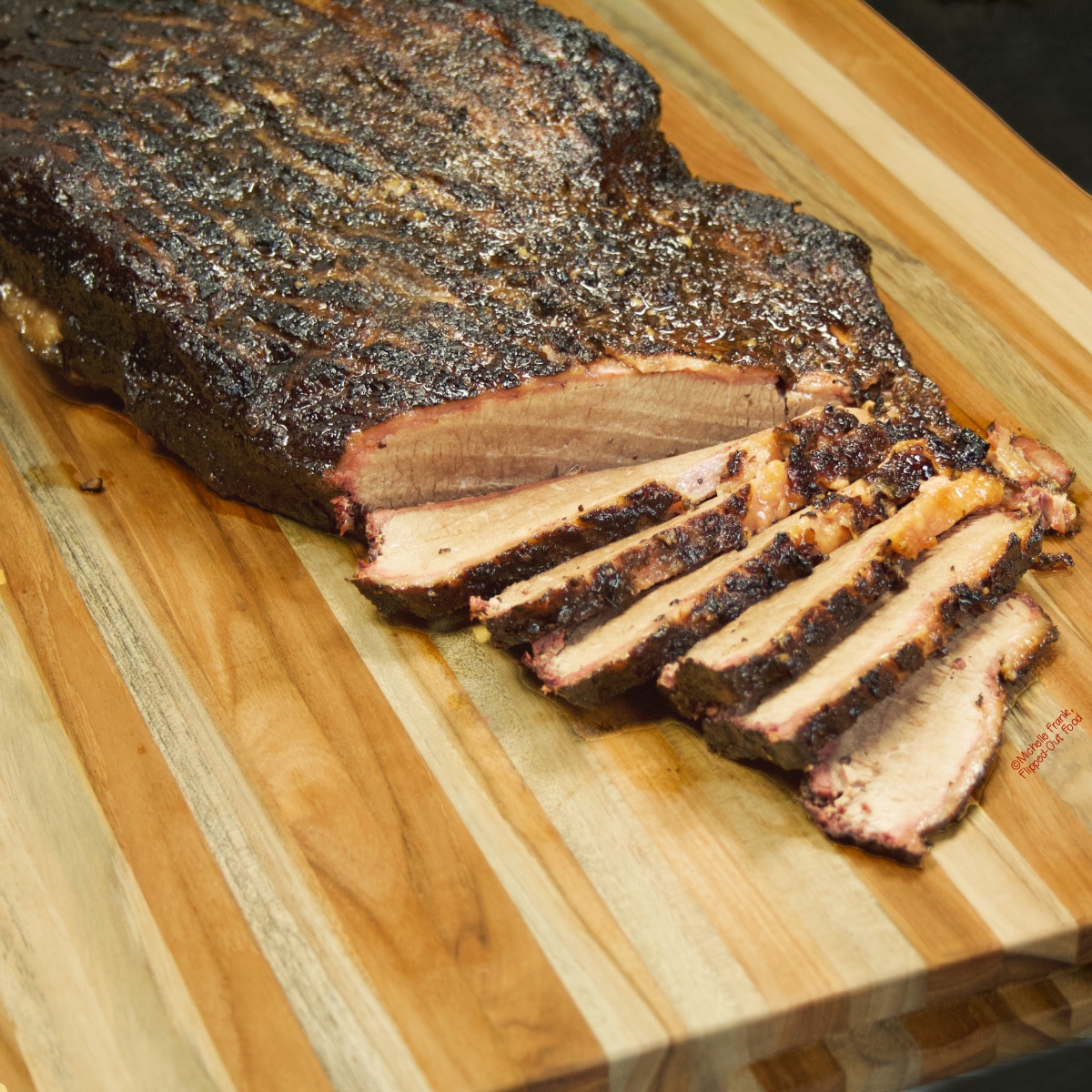
Additional fixings to serve
- Buns or soft dinner rolls for sandwiches
- Small ramekins for au jus
- Sliced onions
- Tiger sauce: 1:1 ratio of mayonnaise and sour cream with some added horseradish
You might be asking, "where's the BBQ sauce?"
Do you put BBQ sauce on brisket ?
NO! Please don't. Brisket has such a rich beefy flavor: don't ruin it with sugary BBQ sauce. Just say NO to drugs . . . BBQ sauce.
What to serve with brisket
Here are some of our favorite sides that are great with smoked brisket:
- Creamy Pasta Salad
- Chimichurri Pasta Salad
- Traditional* Potato Salad
- Easy, Zippy Coleslaw
- Don't forget about dessert! Cast Iron Chocolate Chip Cookie
How to reheat brisket
This is so simple—and another major reason to capture the juice!
Put your leftover sliced brisket and a small amount of brisket juice in a skillet. Set it to medium low and after a couple minutes on each side, you have perfectly tender brisket! Dare I say, as good as the day you cooked it?
Can you freeze smoked brisket?
YES! I do this all the time. Once thawed and reheated, the taste and texture are perfect.
Just tightly wrap your leftovers in plastic and then place in a zip-top freezer bag, removing as much air as possible. Also, save the remaining juice! I pour the juice into a smaller zip-top and freeze that separately.
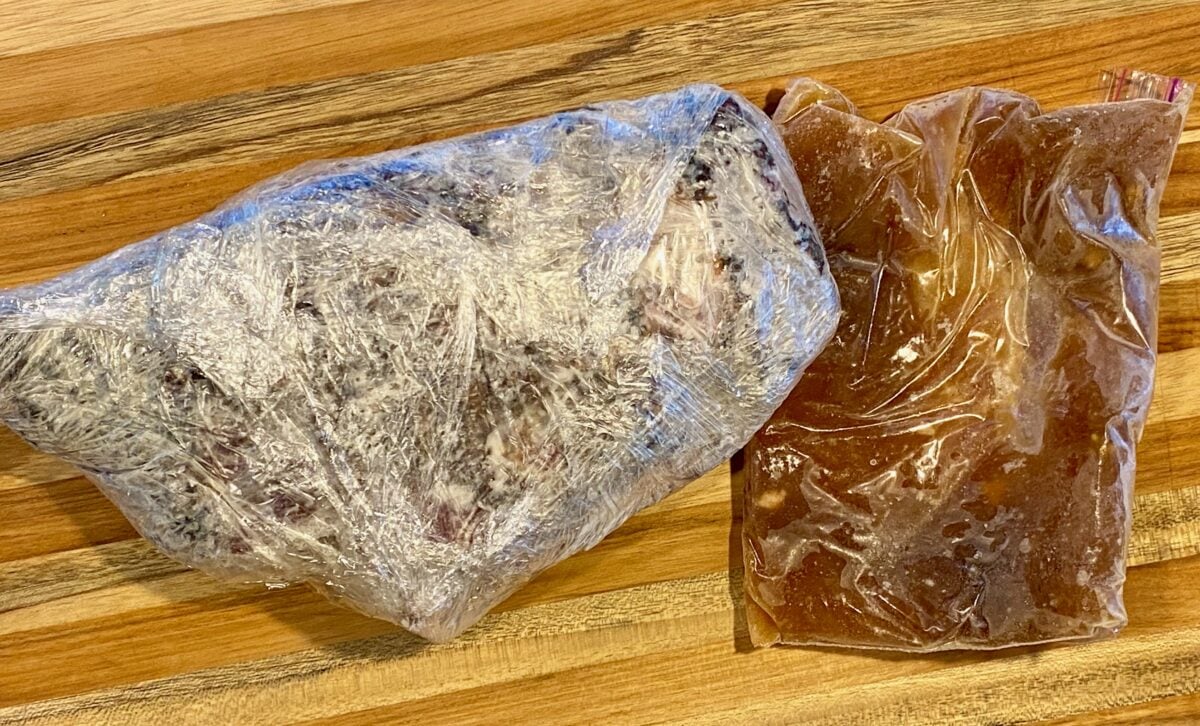
You might be asking, "What are other ways to use leftover brisket?".
Leftover brisket ideas
Leftover brisket is incredibly versatile: you can use it a bunch of different ways. Below are some of our favorite leftover brisket recipes.
Brisket and eggs
Just reheat some smoked brisket slices and serve with eggs and toast. So flavorful.
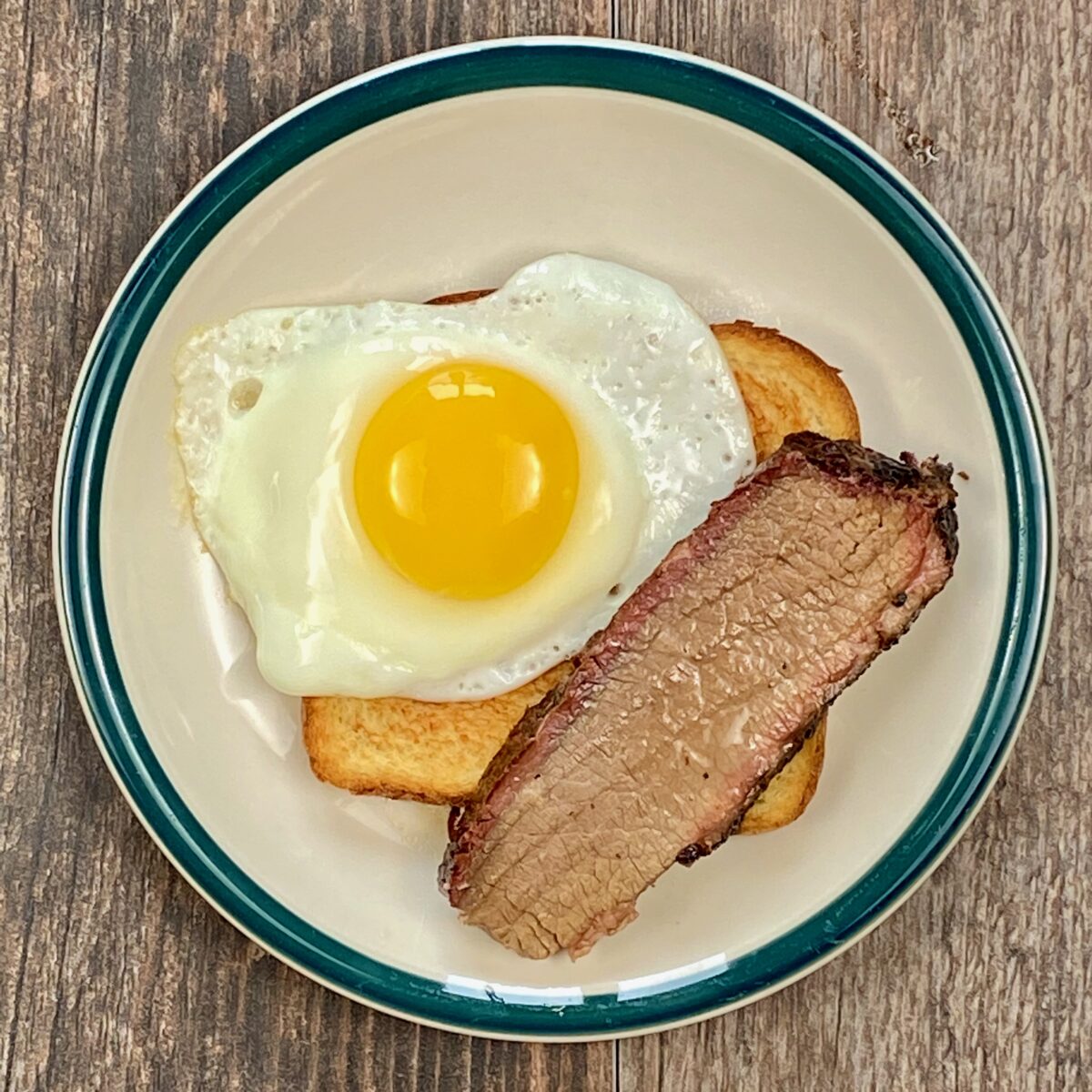
Beef brisket pho (Vietnamese noodle soup)
OMG. This is so good! Follow our recipe "Real Deal" Beef Pho Noodle Soup. Just add sliced brisket and a little of the juice to the pho broth.
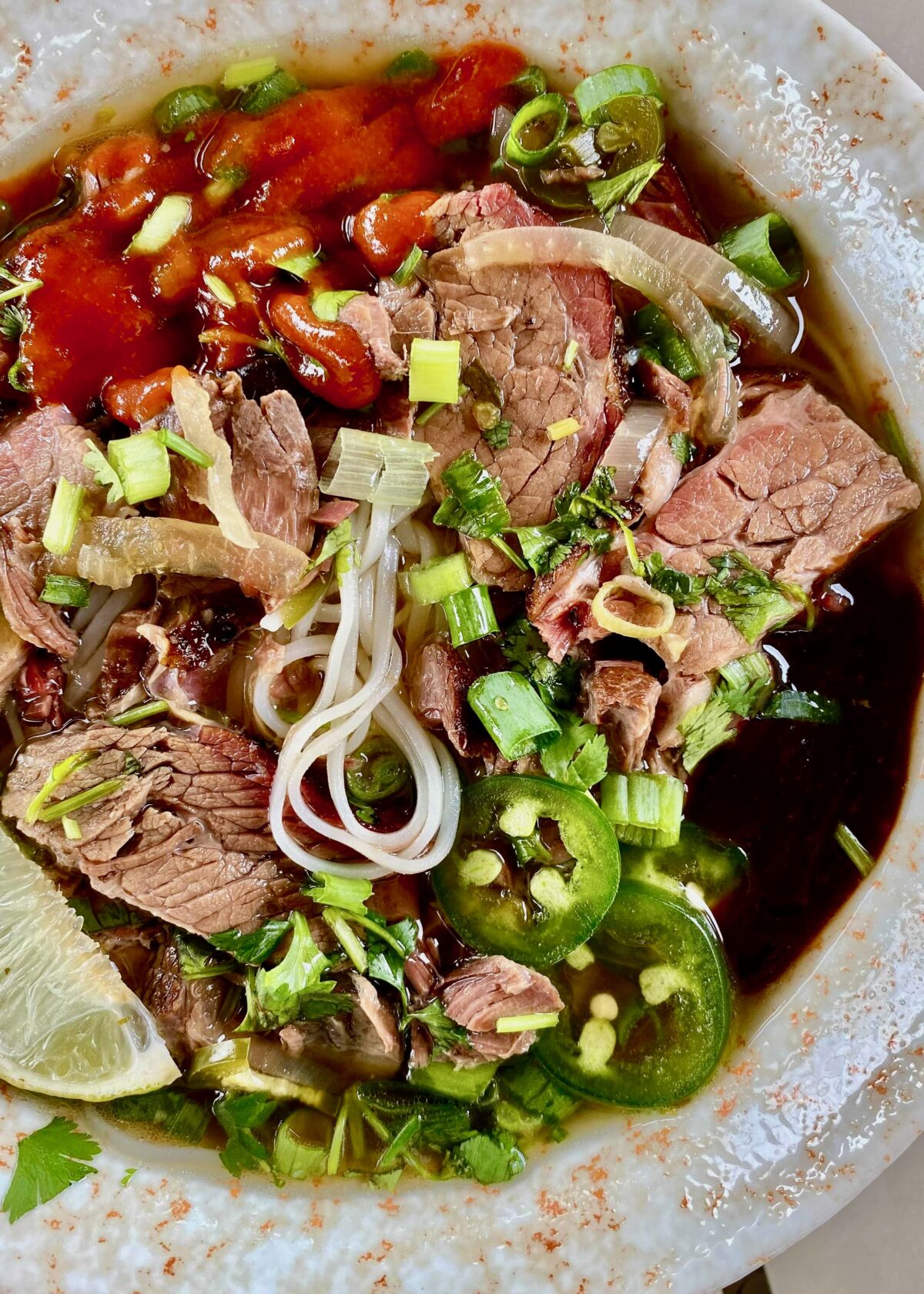
Brisket chili
Add chopped brisket into your favorite chili recipe. Make sure to add some of the flavorful brisket juice to your chili too! It makes the flavor amazing.
Brisket tacos
Chop some brisket and reheat with some taco seasoning, then serve taco shells finished off with your favorite toppings!
Brisket sliders
Or, make a quick brisket slider by spreading a bit of horseradish mayo on one of my sliced Easy Dinner Rolls, then add a couple slices of reheated brisket!
Want more smoked meat recipes?
- Smoked Ribs (Charcoal Grill or Smoker)
- Smoked pork butt (pulled pork)
- Smoked corned beef brisket - coming soon!
- Smoked tri-tip - coming soon!
Good luck and happy smoking!
Ingredients
- 1 14-lb whole packer brisket (cook time will vary depending on what cut you smoke; see Recipe Note #1)
- 2 tablespoons kosher salt (see Recipe Note #2)
- Worcestershire sauce (a few dashes)
- ¼ C beef broth
For the rub:
- 2 teaspoons granulated garlic
- 2 tablespoons coarse ground pepper
Instructions
- Begin by trimming the excess fat off brisket. Leave about ⅛" to ¼" remaining on the fat cap side. Remove all other fat and/or silver skin from opposite side. Rinse and dry thoroughly.
- 24-48 hours before smoking, apply kosher salt around the entire brisket. Use ½ teaspoon kosher salt per pound of trimmed brisket. This is dry brining and will result in juicier meat. (Optional; see Recipe Note #2)
- 1 - 2 hours before smoking, wet the brisket down with a few dashes of Worcestershire sauce. This will act as a binder to hold the rub.
- Immediately apply the ground black pepper and granulated garlic rub. The black pepper should go on at a 3:1 ratio to the garlic powder. (If you didn't dry brine in step 2, apply the salt at this step)
- Preheat your smoker to 250 degrees F.
- Place your brisket on the smoker with the fat cap side towards your heat source. (On a pellet, komodo or charcoal grill, that would mean it is pointing down.)
- Insert a leave-in thermometer into the thickest part of the flat portion of your brisket.
- Once you reach an internal temperature of 165 degrees F, remove from the smoker.
- In a shallow baking pan, place a large sheet of tinfoil that is a minimum of 4" larger on all four sides than your brisket. Create a shallow well in the middle of this tinfoil and pour in the beef broth and a few dashes of worcestershire sauce.
- Place the partially cooked brisket, meat side down (fat cap side up) in the middle of the tinfoil. Place another equal size sheet of tinfoil on top of the brisket and over the first sheet of tinfoI'll. Make multiple folds along all four sides of the tinfoil creating a tight seal between these two sheets of tinfoil with the brisket and juice in the middle. Take these folds all the way up to the meat.
- Place the wrapped brisket on a larger third sheet of tinfoil and fold all four sides up on top of the brisket. This creates two layers of foil. Place the foiled brisket, meat side down (fat cap up), back onto the smoker.
- Once you reach an internal temperature of 203 degrees F, remove from smoker and allow it to rest at room temperature for 1 - 2 hours before slicing.
- Once rested, drain and save the juice from inside the wrap. De-grease and save for later.
- Slice the brisket against the grain in ¼ inch slices and serve with ramekins of the reserved brisket juice.
Notes
- This assumes ½ lb brisket per person. If you're cooking for a smaller group, just cook a brisket flat or point and plan for leftovers.
- if you choose not to dry brine, simply add the kosher salt to the rub ingredients.
Nutrition Information:
Yield: 24 Serving Size: 15 ounces
Amount Per Serving: Calories: 768 Total Fat: 49g Saturated Fat: 19g Trans Fat: 0g Unsaturated Fat: 23g Cholesterol: 280mg Sodium: 458mg Carbohydrates: 1g Fiber: 0g Sugar: 0g Protein: 76g
Nutrition data provided here is only an estimate: if you are tracking this information for medical purposes, please consult a trusted external source. Thanks!
Source: https://www.flippedoutfood.com/smoked-brisket-charcoal-grill-or-smoker/
0 Response to "How to Grill Beef Brisket on Charcoal"
Postar um comentário